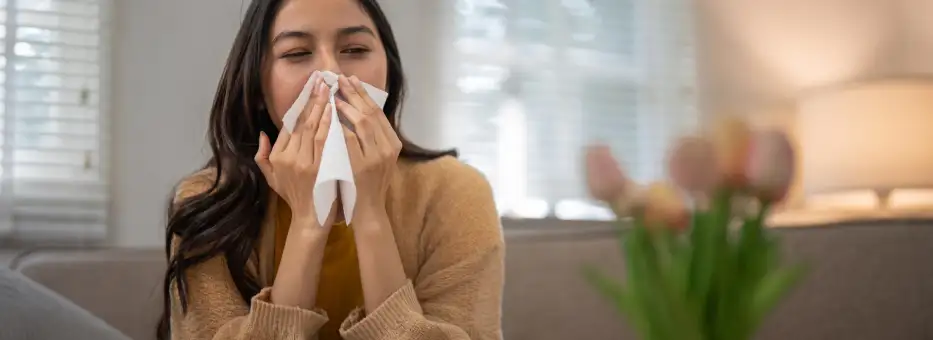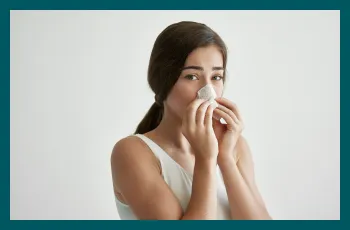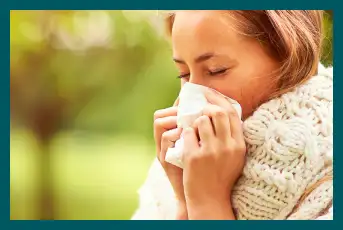Common seasonal allergy symptoms & the best ways to deal with it?
Written by Dr Nelson Lau, MBBS FRACGP, GP & Digital Health Specialist

Contents

With the changing of seasons, it can be a time for crisp air and colourful leaves, but unfortunately (for many of us) it spells the dreaded allergy season. If you’ve ever felt like your body is waging war against nature, you're not alone. In this article, we will look at seasonal allergies and understand what triggers those sniffles and sneezes and learn how to manage them effectively.
What are allergies, anyway?
Imagine your immune system as a vigilant guard, protecting your body from harmful invaders like viruses and bacteria. Allergies occur when this guard becomes a bit overzealous, mistaking harmless substances like pollen or dust mites as threats. This triggers an immune response, leading to the symptoms that we're all familiar with.What is an allergic reaction? An immune system overreaction
Think of an allergic reaction like a fire alarm going off when someone burns toast. The alarm (your immune system) is designed to protect you from a fire (a real threat), but in this case, it’s over-reacting to something harmless. Similarly, when you’re allergic to pollen, your immune system releases histamines and other chemicals to fight off the “invader,” causing itchy eyes, a runny nose, and other frustrating symptoms.Common seasonal allergy symptoms: The usual suspects
Seasonal allergies can manifest in various ways, but some of the most common symptoms include:- Sneezing: Your body’s way of trying to expel the allergen.
- Runny or stuffy nose: Caused by inflammation in the nasal passages.
- Itchy or watery eyes: The histamine release affects the eyes as well.
- Coughing: Can be triggered by postnasal drip or irritation in the throat.
- Fatigue: Dealing with allergies can be exhausting
When do these allergens strike?
In Australia, the timing of allergy season can vary depending on your location and the specific allergen you're sensitive to. Generally, you can expect:- Spring (September to November): Tree pollen is the main culprit during this time.
- Summer (December to February): Grass pollen takes centre stage.
- Autumn (March to May): Weed pollen and mould spores can be problematic.
Types of seasonal allergies: Know your enemy
Below are some of the common types of seasonal allergies that can turn a beautiful day outdoors into a sneezing, sniffling nightmare. Understanding these different culprits is the first step in effectively combating them.Hay fever (Allergic Rhinitis):
This is the most prevalent seasonal allergy, triggered by pollen released from trees, grasses, or weeds. Symptoms can range from the classic runny nose and itchy eyes to fatigue and even sinus headaches.Mould allergies:
Mould spores, microscopic fungi that thrive in moist environments, are another common trigger for seasonal allergies. While mould can be present year-round, it often peaks during humid seasons, especially in areas prone to dampness. Mould allergies can cause a variety of symptoms, including sneezing, coughing, wheezing, and even skin rashes.Tree pollen allergies:
As the trees awaken from their winter slumber and burst into bloom, they release pollen into the air, causing havoc for those with tree pollen allergies. In Australia, springtime (September to November) is when tree pollen is most abundant. Depending on the specific tree species you're allergic to (White Cypress Murray Pine pollen being the highest risk in Australia), you might experience symptoms earlier or later in the season.Grass pollen allergies:
If you find yourself sneezing and sniffling during the warmer months, grass pollen could be the culprit. In Australia, summertime (December to February) is prime time for grass pollen allergies. Picnics, outdoor sports, and even a casual stroll in the park can become challenging when grass pollen is in the air.Weed pollen allergies:
While spring and summer often get the blame for allergy season, autumn can also bring its share of challenges. Weed pollen, particularly from ragweed, can trigger allergies in susceptible individuals. In Australia, autumn (March to May) is when weed pollen is most prevalent.Diagnosing seasonal allergies:
If you suspect you have seasonal allergies, your doctor will likely:- Ask about your symptoms and when they occur.
- Perform a physical examination.
- May recommend allergy testing to identify specific triggers.
Reducing your allergy exposure:
While you can't completely avoid allergens, you can take steps to reduce your exposure:- Keep windows closed during high pollen counts.
- Use air conditioning with a HEPA filter.
- Shower and change clothes after spending time outdoors.
- Wear a mask when gardening or doing yard work.
How do I test for allergies?
Allergy testing can help pinpoint the specific substances that trigger your symptoms. This may involve:- Skin prick tests: A small amount of allergen is applied to your skin to see if it causes a reaction.
- Blood tests: These measure the levels of specific antibodies in your blood. Get a referral for blood test online within minutes.
How long does it take for seasonal allergies to clear up?
The duration of seasonal allergy symptoms can vary depending on the allergen and your individual sensitivity. In general, symptoms tend to persist as long as you're exposed to the trigger. However, with proper management, you can significantly reduce their severity and impact on your life.When to see a doctor?
If your allergy symptoms are severe, persistent, or interfering with your daily life, it's time to see a doctor. They can help you develop a personalised treatment plan to manage your allergies effectively.How can an online doctor help?
In today's digital age, online doctors can be a convenient and accessible option for allergy consultations. They can assess your symptoms, provide advice on managing your allergies, and even prescribe medication if necessary. However, for more severe symptoms and treatments like desensitisation, you will need to see a doctor face to face.Conclusion: Take control of your allergies
Seasonal allergies can be frustrating, but they don't have to control your life. By understanding your triggers, taking steps to reduce your exposure, and seeking appropriate treatment, you can enjoy the beauty of each season without the sneezes and sniffles.Feeling sick and unsure why? Speak with a GP online in 15 minutes.
See a Doctor now
Available 24/7, across Australia.
Feeling sick and unsure why? Speak with a GP online in 15 minutes.
See a Doctor now
Available 24/7, across Australia.
What we treat
- Cough
- Nausea & vomiting
- Fever
- Hayfever
- Fatigue
- Sore throat
- Acne
- Hair loss
- Gout
- Eczema
- Rosacea
- Sunburn
- UTI
- Erectile dysfunction
- Contraception
- Morning sickness
- Morning after pill
- Prostate health
- Anxiety
- Depression
- Stress
- Grief & loss
- Antidepressants
- Premature ejaculation
- Asthma
- Blood pressure
- Blood thinners
- Diabetes
- Cholesterol
- Migraines & headaches
- Allergies
- Body ache
- Heartburn & reflux
- Sleep disorder
- Pain relief
- Gastro
Related Articles
Disclaimer
This blog is for general informational purposes only and does not indicate that Hola Health provides all treatments or preventive measures mentioned. It is not intended to be a substitute for professional medical advice. Always seek the guidance of your doctor or other qualified health professional with any questions you may have regarding your health or a medical condition. For emergencies please immediately contact 000. Any medical topics discussed are intended to educate, not to imply availability through Hola Health.
 Facebook
Facebook  X
X  Copy Link
Copy Link



